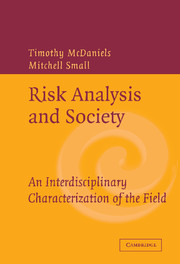Book contents
- Frontmatter
- Contents
- Contributors
- 1 Introduction – Risk Anaysis and Society: An Interdisciplinary Characterization of the Field
- PART ONE FUNDAMENTAL CHARACTER OF RISK
- 2 The Conception of Variability in Risk Analyses: Developments Since 1980
- 3 Mechanistic Considerations in the Harmonization of Dose-Response Methodology: The Role of Redundancy at Different Levels of Biological Organization
- 4 Risk of Extreme and Rare Events: Lessons from a Selection of Approaches
- 5 Environmental Risk and Justice
- PART TWO METHODS FOR RISK ASSESSMENT
- PART THREE NEW APPROACHES AND NEEDS FOR RISK MANAGEMENT
- SUMMARY AND FUTURE DIRECTIONS
- Index
- References
4 - Risk of Extreme and Rare Events: Lessons from a Selection of Approaches
Published online by Cambridge University Press: 05 June 2012
- Frontmatter
- Contents
- Contributors
- 1 Introduction – Risk Anaysis and Society: An Interdisciplinary Characterization of the Field
- PART ONE FUNDAMENTAL CHARACTER OF RISK
- 2 The Conception of Variability in Risk Analyses: Developments Since 1980
- 3 Mechanistic Considerations in the Harmonization of Dose-Response Methodology: The Role of Redundancy at Different Levels of Biological Organization
- 4 Risk of Extreme and Rare Events: Lessons from a Selection of Approaches
- 5 Environmental Risk and Justice
- PART TWO METHODS FOR RISK ASSESSMENT
- PART THREE NEW APPROACHES AND NEEDS FOR RISK MANAGEMENT
- SUMMARY AND FUTURE DIRECTIONS
- Index
- References
Summary
GUILDENSTERN: We have been spinning coins together since I don't know when, and in all that time … I don't suppose either of us was more than a couple of gold pieces up or down. I hope that doesn't sound surprising because its very unsurprisingness is something I am trying to keep hold of. The equanimity of your average tosser of coins depends upon a law, or rather a tendency, or let us say a probability, or at any rate a mathematically calculable chance, which ensures that he will not upset himself by losing too much nor upset his opponent by winning too often. This made for a kind of harmony and a kind of confidence. It related the fortuitous and the ordained into a reassuring union which we recognized as nature. The sun came up about as often as it went down, in the long run, and a coin showed heads about as often as it showed tails. Then a messenger arrived. We had been sent for … Ninety-two coins spun consecutively have come down heads ninety-two consecutive times.
Tom Stoppard Rosencrantz and Guildenstern Are DeadINTRODUCTION
Extreme and rare events have captured our imagination. They have inspired fear, introspection, art, literature, religion, law, science, and engineering. Are they acts of God or acts of man; destined or random; to be expected, designed for, and perhaps controlled, or rather ignored, left off of our “worry budgets,” and responded to only if they occur?
- Type
- Chapter
- Information
- Risk Analysis and SocietyAn Interdisciplinary Characterization of the Field, pp. 74 - 118Publisher: Cambridge University PressPrint publication year: 2003
References
- 1
- Cited by



